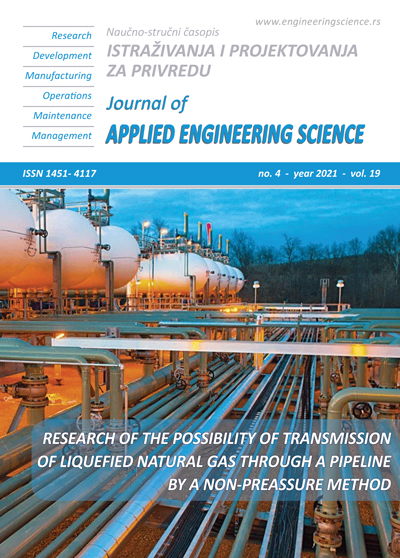UNDERSTANDING THE PURCHASING PORTFOLIO MODEL – A JUST-IN-SEQUENCE APPROACH INCREASING MANUFACTURING EFFICIENCY
Abstract
Just-in-sequence supply solutions are highly searched problems of the scheduling the manufacturing and logistics resources. The cost reduction, efficiency and capacity utilization are based on the controlled and designed parameters of the participants' supply processes and services. To increase logistic operations and other services in supply chain’s inventory activities, the optimization of the supply process is unavoidable. The aim of this article to measure the efficiency of the supply chain’s inventory activities in manufacturing technology processes. Based on the results of the application of our ABC-XYZ model approach to defines the importance of product values in the inventory management systems. The case study and computational results validate the matrix model and evaluates its efforts to renewing manufacturing and delivery processes's efficiency in inventory strartegies based on just-in-sequence strategy.
References
[2] LAGE, M.; FILHO, G. (2010). Variations of the Kanban system: Literature review and classification. In: International Journal of Production Economics, Vol. 125, pp. 13 – 21.
[3] KROOS, K., BINDER, J. (1997). Just-in-sequence delivery of complex chassis systems, pp. 28 – 35. Technische Mitteilungen Krupp.
[4] BÁNYAI, T., ILLÉS, B., GUBÁN, M., GUBÁN, Á., SCHENK, F., BÁNYAI, Á. (2019). Optimization of just-in-sequence supply: A flower pollination algorithm-based approach. In: Sustainability, Vol. 11, No. 14, 3850.
[5] ZHOU, B.-H., PENG, T. (2017). Scheduling methods of just-in-time material replenishment in mixed-model assembly lines. In: Kongzhi yu Juece/Control and Decision, Vol. 32, No. 6, pp. 976 – 982.
[6] SEVERINO, M.R., GODINHO FILHO, M. (2019). POLCA system for supply chain management: simu-lation in the automotive industry. In: Journal of Intelligent Manufacturing, Vol. 30, No. 3, pp. 1271 – 1289.
[7] TAUBE, F., MINNER, S. (2018). Resequencing mixed-model assembly lines with restoration to custom-er orders. In: Omega, Vol. 78, pp. 99 –111.
[8] KANG, Y.-S., KIM, H., LEE, Y.-H. (2018). Implementation of an RFID-based sequencing-error-proofing system for automotive manufacturing logistics. In: Applied Sciences, Vol. 8, No. 1, 109.
[9] HOFMANN, E., RÜSCH, M. (2017). Industry 4.0 and the current status as well as future prospects on logistics. In: Computers in Industry, Vol. 89, pp. 23 –34.
[10] CEDILLO-CAMPOS, M.G., LIZARRAGA-LIZARRAGA, G., MARTNER-PEYRELONGUE, C.D. (2017). MiF3 method: Modeling intermodal fluidity freight flows. In: Research in Transportation Economics, Vol. 61, pp. 15 – 24.
[11] MOCHALIN, S.M., TYUKINA, L.V., NOVIKOVA, T.V., POGULYAEVA, I.V., ROMANENKO, E.V. (2016). Problems of inter-organizational interaction of participants in motor transport cargo shipments. In: Indian Journal of Science and Technology, Vol. 9, No. 21, 95220.
[12] ČUJAN, Z., FEDORKO, G. (2016). Supplying of Assembly Lines Using Train of Trucks. In: Open Engi-neering, Vol. 6, No. 1, pp. 426 – 431.
[13] NUNES, F.D.L., PIRAN, F.S., BORTOLINI, F., ANTUNES, J. (2015). Strategic positioning, classic man-ufacturing strategy and manufacturing strategy of hyundai motor company: An analysis. In: Espacios, Vol. 36, No. 3, 5.
[14] BOYSEN, N., EMDE, S. (2014). Scheduling the part supply of mixed-model assembly lines in line-integrated supermarkets. In: European Journal of Operational Research, Vol. 239, No. 3, pp. 820 – 829.
[15] SULGAN, M., SOSEDOVA, J. (2014). Procurement of materials and components for manufacturing activity. In: Komunikacie, Vol. 16, No. 2, pp. 58 – 62.
[16] BORUCKI, J., PAWLEWSKI, P., CHOWANSKI, W. (2014). Mixing ABS and DES Approach to Modeling of a Delivery Process in the Automotive Industry. In: Communications in Computer and Information Science, Vol. 430, pp. 133 – 143.
[17] HE, C.-P., ZHENG, Y., WANG, L.-Y., MA, D.-Z. (2014). RFID application research for discrete manu-facturing. In: Jisuanji Jicheng Zhizao Xitong/Computer Integrated Manufacturing Systems, Vol. 20, No. 5, pp. 1160 – 1170.
[18] FUNKE, L., ROTTLER, R., TRACHT, K. (2013). Rationalizing in the production of intermediate goods. In: ZWF Zeitschrift fuer Wirtschaftlichen Fabrikbetrieb, Vol. 108, No. 11, pp. 869 – 871.
[19] WAGNER, S.M., SILVEIRA-CAMARGOS, V. (2011). Decision model for the application of just-in-sequence. In: International Journal of Production Research, Vol. 49, No. 19, pp. 5713 – 5736.
[20] MEISSNER, S. (2010). Controlling just-in-sequence flow-production. In: Logistics Research, Vol. 2, No 1, pp. 45 – 53.
[21] CHEN, R.-S., TU, M. (2009). Development of an agent-based system for manufacturing control and coordination with ontology and RFID technology. In: Expert Systems with Applications, Vol. 36, No. 4, pp. 7581 – 7593.
[22] WAGNER, S.M., SILVEIRA-CAMARGOS, V. (2012). Managing risks in just-in-sequence supply net-works: Exploratory evidence from automakers. In: IEEE Transactions on Engineering Management, Vol. 59, No. 1, 5659473.
[23] HÜTTMEIR, A., DE TREVILLE, S., VAN ACKERE, A., MONNIER, L., PRENNINGER, J. (2009). Trading off between heijunka and just-in-sequence. In: International Journal of Production Economics, Vol. 118, No. 2, pp. 501– 507.
[24] PLÖGER, M., HAASIS, H.-D. (2008). Equitably taken just-in-sequence supply in production networks. In: ZWF Zeitschrift fuer Wirtschaftlichen Fabrikbetrieb, Vol. 103, No. 9, pp. 613– 615.
[25] GOTTSAUNER, B. (2007). RFID systems in just-in-sequence production. In: AutoTechnology, Vol. 7, pp. 48 – 51.
[26] HILLIS, D. (2007). The thinking trucks. In: Manufacturing Engineer, Vol. 86, No. 1, pp. 32 – 35.
[27] WILDEMANN, H., FAUST, P. (2004). Just-in-sequence audits towards partnership-based optimization of processes in the automotive industry. In: ZWF Zeitschrift fuer Wirtschaftlichen Fabrikbetrieb, Vol. 99, No. 4, pp. 157 – 161.
[28] BEHNKEN, E. (2004). Strategic networks as form of organisation. In: ZWF Zeitschrift fuer Wirtschaftli-chen Fabrikbetrieb, Vol. 99, No. 12, pp. 731 – 734.
[29] RABE, M. (2003). Simulation of supply chains. In: International Journal of Automotive Technology and Management, Vol. 3, No. 3-4, pp. 368 – 382.
[30] ZACHARIAS, W. (2002). Triaton. Castrum sequence - The control center for just-in-sequence module production in the automotive supply industry. pp. 8+63 – 66, Technische Mitteilungen Krupp.
[31] ROTERS, F. (2000). Just-in-Sequence - The next logical step, In: Bekleidung Wear, pp. 30 – 33.
[32] TAMÁS, P. (2017). Examining the Possibilities for Efficiency Improvement of SMED Method Using Sim-ulation Modelling. In: Manufacturing Technology, Vol. 17, No. 4, pp. 592 – 597.
[33] PRÍSTAVKA, M., KRIŠTOF, K. (2018). Evaluation of Quality Costs in the Production Organization. In: Manufacturing Technology, Vol. 18, No. 3, pp. 466 – 476.

